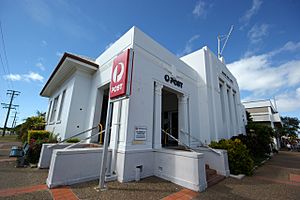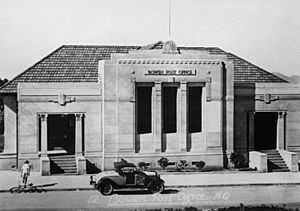Bowen Post Office facts for kids
Quick facts for kids Bowen Post Office |
|
|---|---|

Bowen Post Office, 2009
|
|
| Location | 46 Herbert Street, Bowen, Queensland, Australia |
| Built | 1936 |
| Built for | Postmaster General of Australia |
| Architect | Commonwealth Department of Interior |
| Owner | Australia Post |
| Official name: Bowen Post Office | |
| Type | Listed place (Historic) |
| Designated | 8 November 2011 |
| Reference no. | 106124 |
| Lua error in Module:Location_map at line 420: attempt to index field 'wikibase' (a nil value). | |
The Bowen Post Office is a special old building in Bowen, Australia. It's located at 46 Herbert Street. This building was designed by the Commonwealth Department of the Interior and finished in 1936. It's important because it's on the Commonwealth Heritage List, which means it's a protected historical site.
Contents
History of Bowen and its Post Office
How Bowen Started
Bowen is a town in North Queensland, Australia. It's about halfway between Townsville and Mackay. The town was founded on April 12, 1861. This makes it the oldest town in the region.
George Dalrymple named the town after Sir George Bowen. Sir George was the very first Governor of Queensland. In the same year, Port Denison (Bowen's port) became an official entry point. Soon after, a large wooden jetty was built in 1865.
Growing Connections
In 1869, a telegraph line opened between Bowen and Townsville. This allowed people to send messages quickly over long distances. The port also improved with the finished jetty and a deeper harbour. This made Bowen a key place for shipping goods, mail, and passengers.
By 1910, a special tramway connected Proserpine to Bowen. This meant sugar from the Proserpine Sugar Mill could be shipped from Port Denison. A railway line connecting Bowen to Townsville opened in 1913, making travel and transport even easier.
Where the Post Office Stands
Herbert Street is the main road in Bowen. It leads down to the port. The street is wide with a garden area in the middle. The Bowen Post Office, built in 1936, is on the corner of Herbert and Powell Streets. It replaced an older post office that was on a different street.
Many other important town buildings are nearby. These include the Bowen Shire Chambers (council offices), the memorial club, and the Bowen courthouse. There's also a police and ambulance station close by. The Post Office was designed by the Commonwealth Department of Interior. Architect Horace Mackennal was in charge of the design.
What the Post Office Looks Like
Outside the Building
The Bowen Post Office is at 46 Herbert Street, on the corner of Powell Street. It's at the top of the main street, which gently slopes down to the port. Other important buildings like the courthouse and council offices are nearby.
The Post Office was built in 1936. It has a smooth, rendered front facing Herbert Street. It looks like many post offices built in Queensland after the 1910s. It has two entry porches on the corners. A central section is between them. This central part used to have telephone booths and the main counter.
The building has an Art Deco style, especially on the Herbert Street side. You can see decorative lines and stepped shapes near the top. There are also sculpted decorations on the walls. The corner porches have columns with special tops and keystones above the openings.
The back and sides of the building have smooth walls. They have decorative tops and windows with raised frames. These parts look like the Georgian Revival style. This style was also used for the Ayr Post Office, built in the same year.
Inside the Building
You can enter the main shop area from either corner porch. The west porch also leads to the post office box lobby. This area was added later into what used to be the mailroom.
The inside of the building has three main parts. These are the retail shop and counter, the mail sorting room, and the post office box lobby. There are also staff rooms, storage areas, and a service delivery area. A basement level under the back of the building is used for storage.
The building has one main floor and a basement. It is built with strong brick walls. The floors and roof are made of timber. The outside walls are brick covered with a smooth finish. The windows have special patterns. Inside, many walls are smooth with decorative details. The ceilings are made of plaster. The roof is tiled with terracotta.
How it Has Changed
The original design of the Post Office had two porches and a central hall. It allowed the postal and telegraph services to work separately. The main public area had telephone booths and a counter. The mailroom was behind this.
Most of the original inside walls are still there. However, new walls have been added to make smaller rooms. For example, the mailroom is now divided into three sections. A new mailroom and loading area have been added to the building's back.
Even with these changes, the outside of the building still looks much like it did originally. You can still see its special front, roof, and smooth walls. The building is in good condition, both inside and out.
Why it's a Heritage Site
The Bowen Post Office was added to the Commonwealth Heritage List on November 8, 2011. This means it's recognized as an important part of Australia's history and culture.
Important for History (Criterion A)
The Bowen Post Office was built in 1936. It's one of many post offices built across Queensland during that time. These buildings helped towns and regions grow. The Post Office shows how the area developed. The main postal building from 1936 is the most important part of this heritage listing.
Special and Rare Design (Criterion B)
The Post Office has Art Deco details on its front. While these details are simple, they are quite rare for post offices of that time. The special columns, decorative tops, and smooth walls make its design unique.
What it Represents (Criterion D)
The Bowen Post Office is a good example of:
- A retail post office from the 1930s to 1970s. This type of post office started to focus more on selling things.
- Architecture from the period between 1915 and 1942. It mixes old styles with Art Deco touches.
- A building designed by the Commonwealth Department of the Interior under Horace Mackennal.
This post office shows how postal services changed. It was designed so that postal and telegraph services could work separately. Later, the inside was changed to make the retail area bigger.
Bowen Post Office is one of three similar post offices built in Queensland around the same time. The others are Ayr Post Office (1936) and Ingham Post Office (1935). These buildings often have a similar layout and are found near other important town buildings, like war memorials.
Beautiful Features (Criterion E)
The Bowen Post Office is a building that looks important, even though it's not huge. Its special front facing Herbert Street makes it stand out. It's also near other important buildings like the council offices and courthouse. Together, these buildings make Herbert Street look very civic and important.
Important to the Community (Criterion G)
The Bowen Post Office was built in 1936. It replaced an older post office. For over 70 years, postal services have been offered from this building. This long history makes it very important to the local community.
Images for kids




